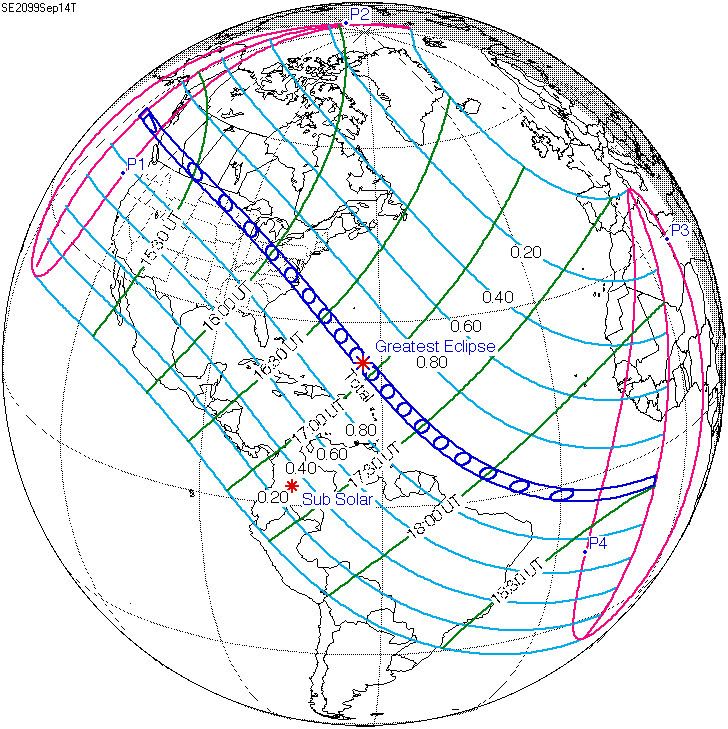Nature Total Magnitude 1.0684 Max. width of band 241 km (150 mi) Start date September 14, 2099 | Gamma 0.3942 Duration 318 sec (5 m 18 s) Greatest eclipse 16:57:53 | |
 | ||
A total solar eclipse will occur on September 14, 2099. A solar eclipse occurs when the Moon passes between Earth and the Sun, thereby totally or partly obscuring the image of the Sun for a viewer on Earth. A total solar eclipse occurs when the Moon's apparent diameter is larger than the Sun's, blocking all direct sunlight, turning day into darkness. Totality occurs in a narrow path across Earth's surface, with the partial solar eclipse visible over a surrounding region thousands of kilometres wide.
Contents
Visibility
It will begin at sunrise off the western coast of Canada, and move eastern across Canada (British Columbia, Alberta, and Saskatchewan) and the northern states of the United States (North Dakota, Minnesota, Wisconsin, Ohio, the Virginias, and North Carolina) and end in the Atlantic ocean. Partiality will be visible throughout North America and South America including most of Brazil.
The total eclipse will pass through the cities of Minneapolis, Minnesota, Madison, Wisconsin, and Grand Rapids, Michigan. The last total solar eclipse over these three cities respectively was June 30, 1954, May 16, 1379, and April 18, 1558.
Solar eclipses 2098-2100
Each member in a semester series of solar eclipses repeats approximately every 177 days and 4 hours (a semester) at alternating nodes of the Moon's orbit.
Saros 136
Solar Saros 136, repeating every 18 years, 11 days, contains 71 events. The series started with partial solar eclipse on Jun 14, 1360, and reached a first annular eclipse on September 8, 1504. It was a hybrid event from November 22, 1612, through January 17, 1703, and total eclipses from January 27, 1721 through May 13, 2496. The series ends at member 71 as a partial eclipse on July 30, 2622, with the entire series lasting 1262 years. The longest eclipse occurred on June 20, 1955, with a maximum duration of totality at 7 minutes, 8 seconds.
Inex series
This eclipse is a part of the long period inex cycle, repeating at alternating nodes, every 358 synodic months (≈ 10,571.95 days, or 29 years minus 20 days). Their appearance and longitude are irregular due to a lack of synchronization with the anomalistic month (period of perigee). However, groupings of 3 inex cycles (≈ 87 years minus 2 months) comes close (≈ 1,151.02 anomalistic months), so eclipses are similar in these groupings.
